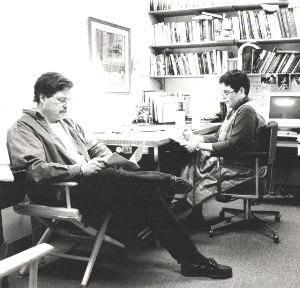Though I always “had power” over the final grades I reported to students, I reminded students that they “had power” over what they turned in. My classroom was a place where completion was far more important than perfection, as I’m committed to a philosophy that if 25 people meet every day to talk about books and writing and go away to read and write for a couple hours every day in preparation for the next conversation, they will learn and grow, always.
(This is a bit of an oversimplified model but it fits with everything I know about learning, reading, and writing: Do the reading and writing, and you can’t help learning.)
Of course, it was my philosophy that was enacted, since I was the one who had the power to enact. That much was inescapable, in the same way that anybody doing a job has power over how they do the job. You can spit on my hamburger, or not.
Midway through my teaching career, in my English composition classes, I started a practice I kept up for years, no matter how much work it was or how much discomfort it caused (and as I say this, I may have just gained insight into how my tenure process went so far off the rails…) because I think people get uncomfortable when they learn and work hard. That is, I think learning causes discomfort. The practice was this: I’d create a syllabus for the quarter with an overall structure in place, including various categories for which students could earn credit (e.g., showing up, writing papers, doing regular assignments, submitting a final portfolio), and then I’d require the class to reach consensus regarding the distribution of percentage weights (or points) for the various activities.
Theoretically, students could decide to place all the weight on one area of activity, or to distribute the weight perfectly evenly, or to calculate the effort they thought each task would take and reward those tasks that took the most time and effort with more points — or fewer, if they wanted to give themselves an “unfair” edge. The process for creating plans started from individual proposals shared in pairs; the pair worked out a compromise between them and joined another pair to work out a new compromise, then to 8s, and so on, until the entire class had a plan they could live with.
That was the rule: It didn’t have to be perfect, it had to be a plan they could live with. And there needed to be consensus, which means everyone needed to either contribute actively to the decisions or agree that others would make the decisions — you know, kind of like in democracy.
This was a slow and at times arduous process. I facilitated the group work, but I resolutely resisted stepping in to undo the students’ ideas and insert my own. Many of them hated this. Many of them talked for a long time after about how they had never gone through a consensus-based decision-making process before. None of them ever told me they’d been given a task like this.
Some statistics:
- Longest time spent coming to a final consensus: about a full week of class. (I’ve heard of a Lutheran women’s group that operates by consensus, and their decision-making can take years.)
- Frequency of 1 student versus the rest of the room: Two times there was one student who felt they needed to stand up against the mob. In one of those cases, I think the student was deliberately trying to shake things up, and in the other, the student really wanted others to rethink their positions.
- Number of classes over the years that came up with the same plan: 0.
One reason this practice was important to me was semi-therapeutic: I needed to address my discomfort with hierarchy. I could lead but I couldn’t boss, not comfortably. As my kids were born and grew and started school, and as my marriage persisted over years, I found myself questioning why I would treat my students differently from the way I wanted my children treated in school and the way I wanted to treat others and be treated: with trust.
A colleague, sort of a roguish radical who seems committed to more extreme political ideas than mine, asked me how I was able to reconcile my educational philosophy (anti-grading, pro-choice, self-directed learning, democratic decision-making) with teaching in a mainstream institution in which grades were used to communicate the value of the work. Starting the quarter without the syllabus being finalized and requiring others to join in creating the structure was one way.
Or was that just the way I asked the prisoners to build their own cage?

